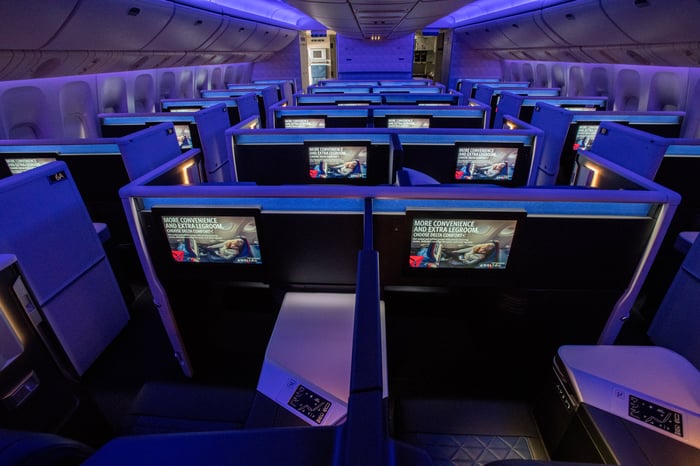The COVID-19 pandemic caused air travel demand to crash, upending the airline industry. One major result is that airlines have had to completely rethink their fleet strategies. Most airline executives expect demand to remain depressed for several years, which means that fewer aircraft will be needed in the short term.
The silver lining is that airlines are now thinking more strategically about their fleets -- and considering moves that could be painful now but drive substantial cost reductions in the long run. Delta Air Lines (DAL 9.00%) is being particularly aggressive on this front, and it may have some of the biggest long-term opportunities as it upgrades and simplifies its fleet.
Three aircraft types are already retiring
In late April, Delta announced that it would accelerate the retirement of two older jet models: the MD-88 and MD-90. The MD-88s were already scheduled to retire later this year, followed by the MD-90s in 2022, but the final flights were moved up to early June.
A bolder move was Delta's May decision to retire its Boeing 777 fleet by year-end. Whereas the MD-88s and MD-90s were roughly 29 and 23 years old, on average, the 777 fleet has an average age of just 15 years. That's relatively young to retire a plane. Moreover, Delta recently finished an expensive project to renovate the 777 interiors to add premium economy seats and upgrade the Delta One cabin to mini-suites.

Delta recently finished upgrading the interiors of its 777 fleet. Image source: Delta Air Lines.
Those investments are sunk costs, though, and Delta has just 18 777s out of nearly 900 mainline aircraft. Standardizing on the Airbus A350 for the carrier's longest routes will reduce complexity -- and Delta's new A350s are 21% more fuel-efficient than the 777s. The already-confirmed fleet simplification moves will save hundreds of millions of dollars annually, according to Delta CFO Paul Jacobson.
The Boeing 717 could be on the chopping block, too
The MD-88, MD-90, and 777 are the only models Delta will retire outright during 2020. But the Boeing 717 may be on its way out, too. Last month, Delta confirmed that it will close two of its four 717 pilot bases and operate just 30 to 45 of its 91 Boeing 717s over the next two years.
The average age of Delta's 717 fleet is a little less than 19 years. The fundamental issue Delta faces with this fleet is that under an FAA directive, it must replace the seats on all of its 717s by mid-2022. Prior to the pandemic, the airline had planned to install seat-back TVs and upgrade other aspects of the cabin in conjunction with that project, extending the lives of its 717s to around 2030.
Now, Delta has to think harder about how long it wants to keep the 717s and (depending on the answer to that question) whether it still makes sense to invest what would likely be millions of dollars per aircraft. The airline has already floated the possibility of trading in its 717s to Boeing in exchange for placing a 737 MAX order.
While most of Delta's 717s are leased, with expiration dates beginning in 2024, the annual lease costs for the fleet are probably just over $100 million. Rather than pouring more money into the 717 fleet -- and accepting additional fleet complexity over the next decade -- it may make sense to phase them out by mid-2022 and buy additional state-of-the-art Airbus A220s instead. The upfront costs will be higher, of course, but the A220s will be cheaper to operate and could potentially last until 2050. Accelerating this transition by a decade will enable Delta to capture the benefits of a simplified fleet much sooner.
Boeing 757s and 767s will linger a while longer
The other aging aircraft type in Delta's fleet is the Boeing 757 and its wide-body cousin, the 767. While these planes are more than 22 years old on average -- and some older 757s and 767s will be retired this year -- these models are likely to remain in Delta's fleet for many years to come.
The 717 has an excellent direct replacement in the A220-100. By contrast, while the A321 and A321neo can replace 757s that operate in the domestic market, they don't have enough range to replace the 757 on longer-haul routes, such as flights to Europe. Delta will have to wait until Airbus' A321XLR model becomes available a few years from now to have a good replacement for its 757s on long-haul routes.
As for the 767, Delta plans to replace many of these planes with the A330-900neo. (It had been interested in Boeing's NMA concept, but that has been shelved due to the 737 MAX grounding and the COVID-19 pandemic.) Delta's A330-900neos have 281 seats: 18% more than even the largest version of the 767. With international travel demand expected to be weak over the next few years, Delta would be foolish to get rid of its smallest international aircraft when there is no direct replacement.

Image source: Delta Air Lines.
The potential upside is tremendous
Delta's fleet simplification plans didn't just spring up during the pandemic. Six months ago, the airline revealed that it wanted to move to a "future state" with just eight fleet families: down from 15 in 2009 and 13 in 2020. However, at the time, this seemed like a far-off aspiration. Now, management is getting serious about making progress toward this goal quickly.
Having fewer aircraft types will reduce maintenance expenses, increase pilot productivity, simplify scheduling, and make it easier to recover when weather or other factors disrupt operations. Incurring some writedowns and additional capital expenditures in the short term may be worthwhile if it enables Delta Air Lines to reach this highly desirable "future state" sooner.





